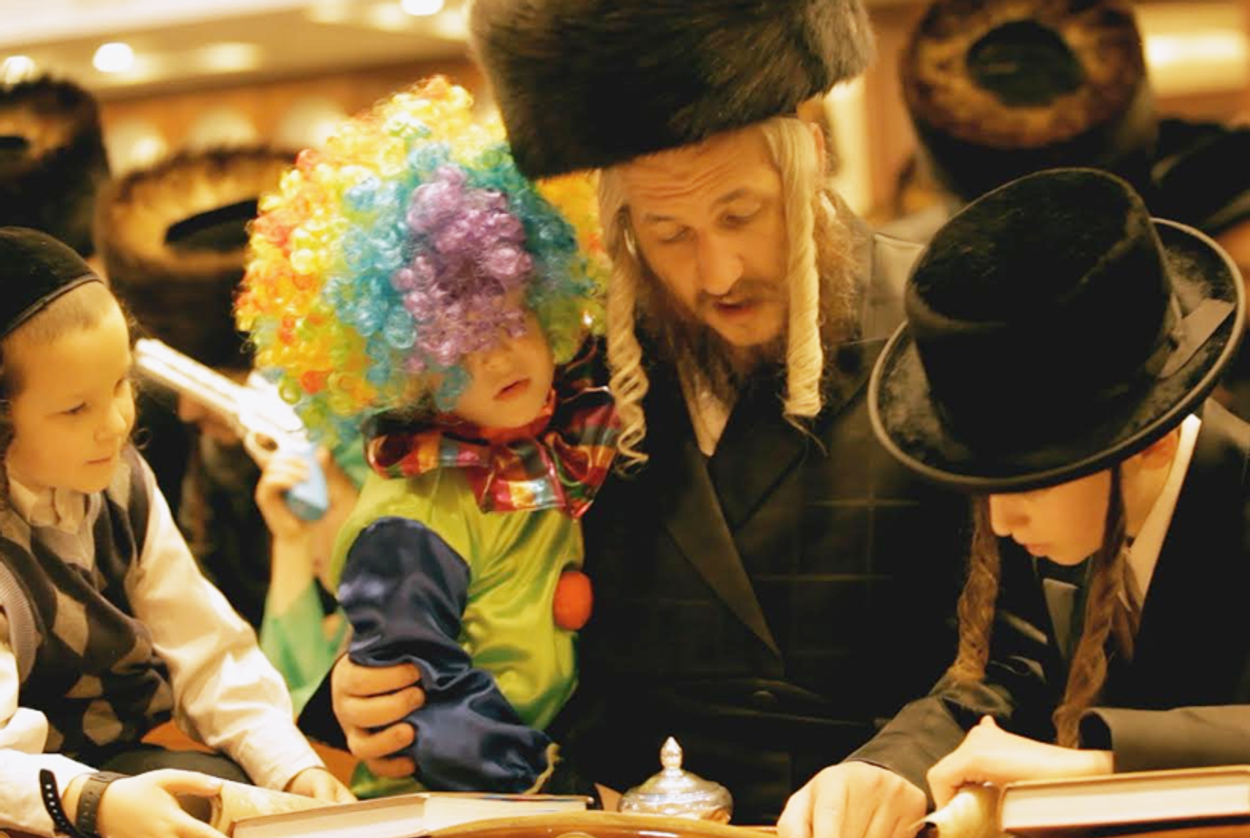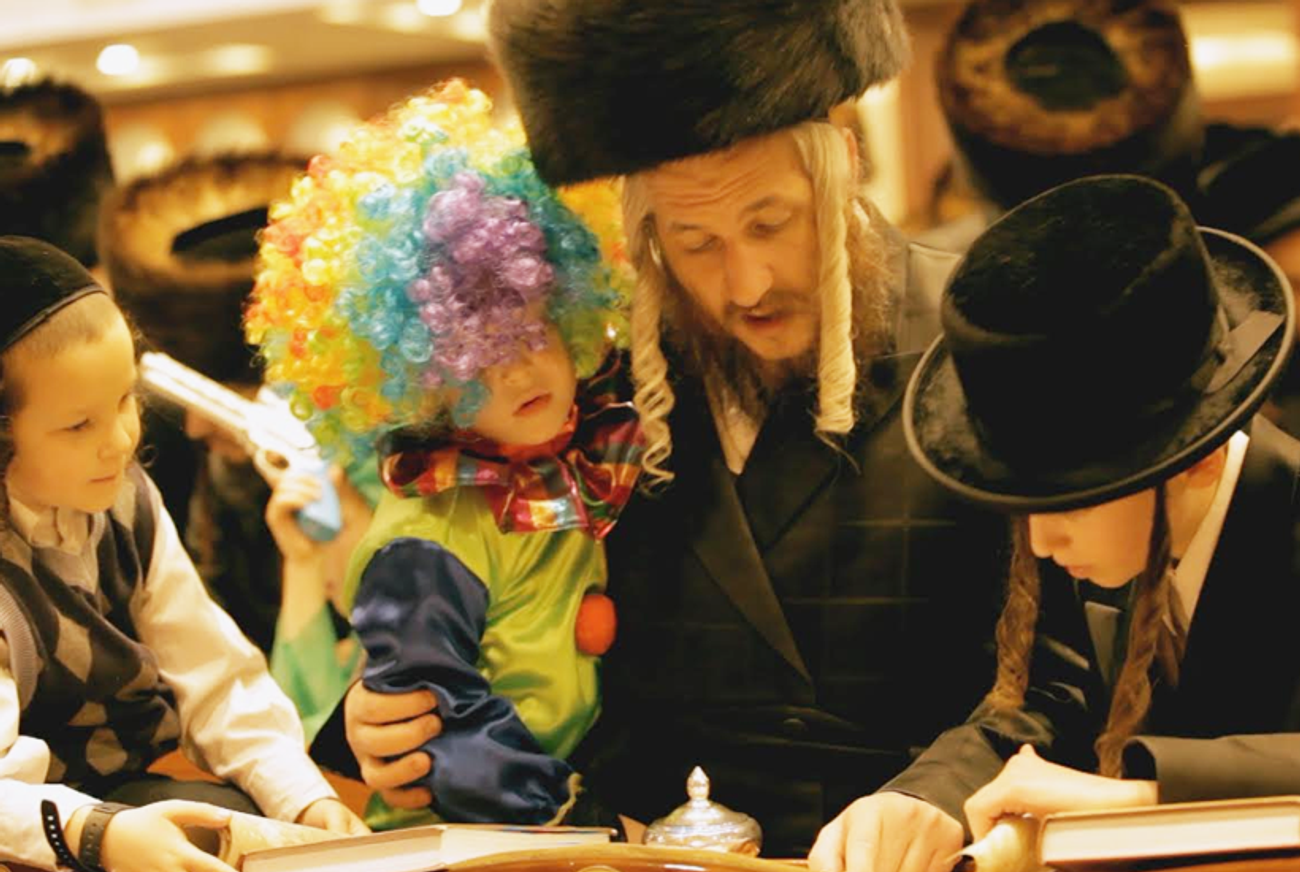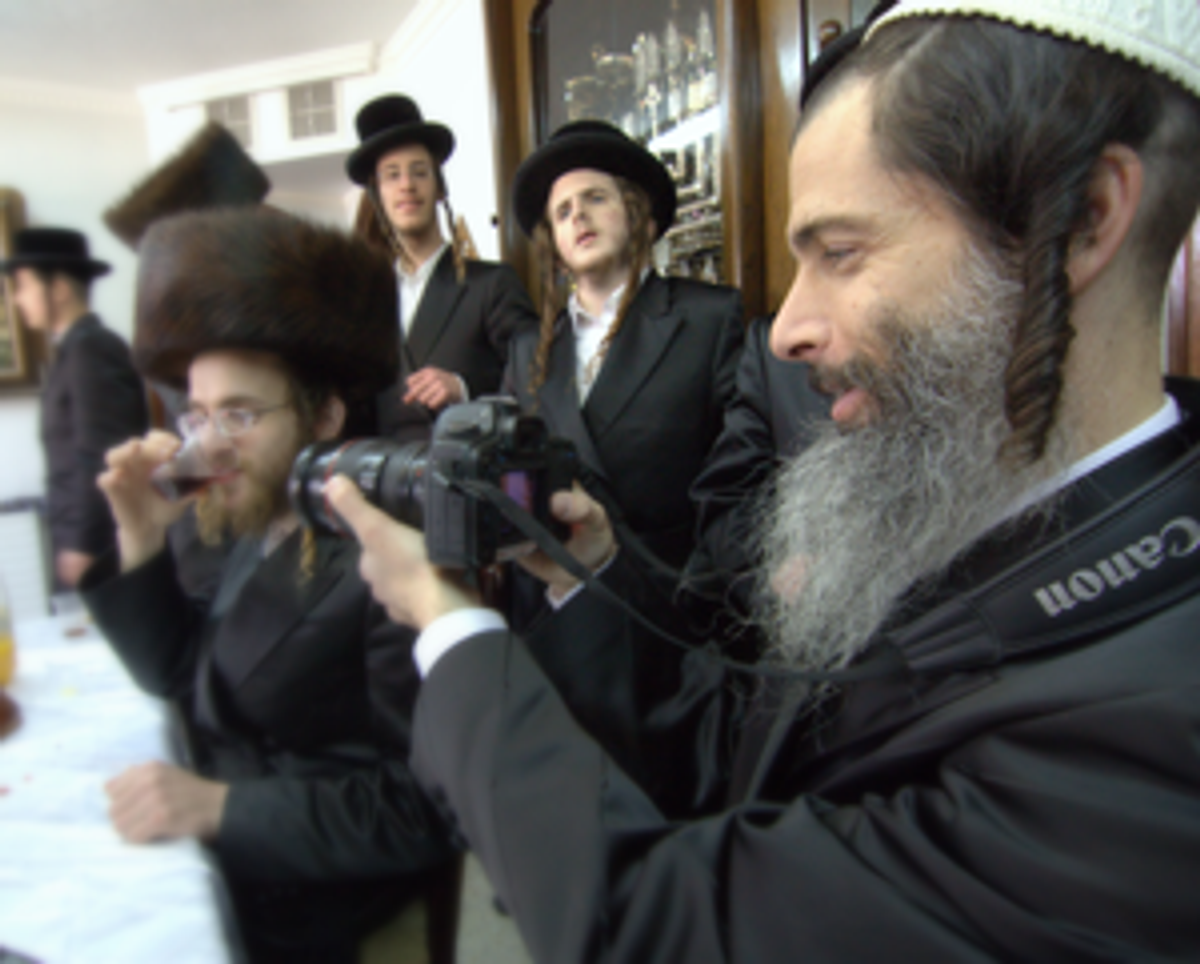A Very Haredi Purim: Devotion Beneath the Debauchery
Filmmaker Ori Gruder captures ultra-Orthodox observance of the holiday in his Israeli TV documentary, ‘A Freilichin Purim’




A Talmudic sage once said, “Where wine enters, secrets emerge.” The ancient aphorism might as well be the tag-line for Ori Gruder’s latest documentary, A Freilichin Purim, which takes viewers inside Israel’s ultra-Orthodox community during the festive holiday. At first glance, Purim—Judaism’s annual day of celebration, drinking, and dress-up—might, compared to seemingly more spiritual occasions like Yom Kippur, seem like an odd time to explore the Haredi world. But Gruder’s film, which airs this week on Israeli television to coincide with the holiday, makes a strong case that beneath the debauchery lies a deeper devotion.
Gruder became ultra-Orthodox 14 years ago, and he initially perceived Purim as a throwback to his previous life as a Tel Aviv beachfront filmmaker. “When I became religious, I saw Purim as something that reminded me of my past,” he told me in a recent interview. “It’s something that is unusual—for a Jew to go and be drunk and get high. You should get high by praying and studying the Torah, but to drink and dance? It looks like a big party. But then I realized that Purim is deeper than that, and that’s what I wanted to show.”
Sensitively bringing the insular ultra-Orthodox community to the screens of mainstream Israeli society is a tricky task but one that Gruder’s personal biography makes him uniquely suited to tackle. Before becoming Haredi at the age of 30, Gruder spent three years as a photographer in the Israel Defense Forces, four years in film school, and several more working his way up the ladder of the Israeli media industry. “I had a very good job working for television, they were flying me around the world to shoot stuff, I had a home in front of the Jaffa harbor—friends, parties, girlfriends, everything,” he recalled. “But something was lacking for me inside.” Fittingly, Gruder’s moment of personal transformation took place behind the camera. “I was flying to Uman to film [the Hasidic celebration of] Rosh Hashanah, and when I was filming there, although I was totally secular, I felt something changing inside of me,” he said. “I wanted to be like what I was filming, not to be on the other side of the lens.” He returned home and within a year had joined the ultra-Orthodox community.

But he didn’t abandon film. Instead, he began using the medium to bridge the chasm between the world he left and the world he joined. Last year, with rabbinic approval, he produced a documentary titled Sacred Sperm, which delved into the thorny subject of ultra-Orthodox sexual ethics, including the prohibition against masturbation. The film aired on Israel’s Channel 8 to wide acclaim and has since been picked up for U.S. distribution. A Freilichin Purim is Gruder’s next foray into this unusual cross-cultural genre.
The film follows six ultra-Orthodox Jews as they observe Purim, each of them offering a very different window into Haredi society. Traditionally, religious Jews are called upon to fulfill four mitzvot (commandments) on the festival: 1) to exchange mishloach manot, or gift baskets of food; 2) to donate matanot la’evyonim, alms to the poor; 3) to hear the Megillah, the story of Purim as recounted in the Scroll of Esther; and 4) to partake in a festive meal, typically involving alcohol. And so, in selecting his subjects, Gruder looked for individuals who embodied each of these commandments, telling his team, “Let’s find people who take each mitzvah to the extreme, who live the mitzvah.”
The first such individual is Rabbanit Tzvia Eliyahu, the wife of the late Israeli Chief Rabbi Mordechai Eliyahu. The film depicts her receiving and distributing countless mishloach manot at her home throughout the day, while offering learned words of spiritual encouragement to her guests. The camera follows her as she leads a large gathering of women in prayer and song, and even corrects a male Megillah reader when he stumbles over a word. To capture these rare moments without running afoul of Haredi modesty norms, Gruder employed an all-female film crew to tail Eliyahu during the holiday.
Viewers then meet Rabbi Yisrael Felner, a top official in Israel’s largest charity, Kupat ha-Ir in Bnei Brak. Each year, Felner relates in the movie, “my 11 children celebrate Purim without me.” Instead, he spends the holiday distributing 6 million shekels to the needy. Gruder’s film marks the first time cameras have been allowed into the charity’s offices.
The movie then moves away from those ultra-Orthodox Jews distributing money on Purim to those receiving it—specifically, two Haredi yeshiva students named Yehuda Zaks and Nahman Klein. In their dilapidated dorm, Gruder films the duo’s pre-Purim planning meeting, in which they set an ambitious collection goal of a half-million shekels. But the money, we soon discover, isn’t for their yeshiva; it’s for fellow students who need funds for their weddings. Beginning on Purim morning, and accompanied by Gruder’s cameras, the students embark on a costumed cross-country trek, knocking on doors of homes, dancing and dining with the occupants, and emerging with checks made out to their marriage fund.
Next up is Rabbi Baruch Mordechai Frank, a Breslover Hasid in Jerusalem, who holds a festive meal each year with the goal of enabling participants to perceive “the light of Purim.” There is much wine involved. Frank explains that “it is not easy to drink” but “we need to escape our minds,” which hamper perception of the transcendent. By the end of the film, Gruder captures Frank calling out to God in a surprisingly affecting drunken reverie.
The movie’s final storyline follows Rabbi Yirmiyah Hayim Damen, the chief cantor in the Great Synagogue of Belz in Jerusalem, who is to read the Megillah for 10,000 Belzer Hasidim—men, women, and children—in the synagogue’s cavernous main sanctuary. As the camera pans across the room’s majestic architecture, capturing Haredi children in full costume shaking groggers to drown out Haman’s name, it offers secular Israeli viewers a glimpse into a world they’d otherwise never have experienced, inside a building they would never have dared to enter.
Weaving all of these disparate strands together is perhaps the most unique feature of the film: a rhyming musical narration performed by a Hasidic bard. Originally, Gruder had intended to use a traditional voiceover to guide viewers through the documentary’s parallel storylines. But at the suggestion of his editor, he hired Ahraleh Weintraub instead. Weintraub is something of a celebrity in Haredi circles, where he composes and performs grammans—lyrical Yiddish or Hebrew personalized poems—at weddings and other celebratory functions, for substantial fees. In A Freilichin Purim, Weintraub acts as a sort of one-man Shakespearean chorus in a streimel, singing rhyming introductions to each character, transitioning between scenes, and interweaving the traditional Purim story throughout. Gruder tells me he finds these interludes particularly fitting, because after all, “Purim is a big musical.”
Weintraub’s inclusion is just one of Gruder’s many sharp artistic choices. Throughout the film, his deft insider’s touch makes each moment feel honest and intimate, rather than voyeuristic. The ultra-Orthodox and their practices are not there to be ogled, but to be experienced. At the same time, although Gruder is informed by his past secular sensibility, he makes no attempt at apologetics for his audience. The Israeli Haredi community is depicted in all its spiritual glory, material poverty, and social patriarchy. It is left to viewers to make up their own minds about its merits, without Gruder telling them where to end up—a rarity for most documentaries, let alone those dealing with religion.
If there is a moral to the movie, it’s not about the value of Haredi Judaism for secular Israel, but about the meaning of Purim in Haredi life. At the outset, Purim might appear to be an uncomfortably boisterous religious observance awkwardly foisted onto a community of pious ascetics. But by film’s end, the day is revealed to be a celebration of community, charity, and spirituality, which brings together the many different sects of ultra-Orthodoxy for a single transcendent moment. “It is good that the Jewish people is united together in celebration,” observes Rabbanit Eliyahu toward the end of the film. “That’s saying a lot.”
“All year,” she concludes, “should be like Purim.”
A Freilichin Purim airs Wednesday on Israel’s Channel 1. It can be viewed online, in Hebrew, here.
Yair Rosenberg is a senior writer at Tablet. Subscribe to his newsletter, listen to his music, and follow him on Twitter and Facebook.